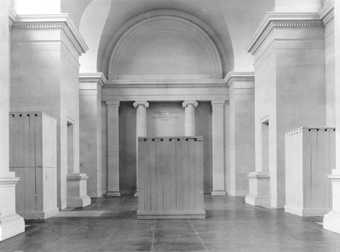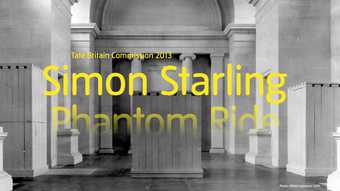Tate Britain
12 March – 20 October 2013
Open every day from 10:00 – 18:00. Free Admission

Alfred Carlebach 1939
© Tate Archive 2003
Tate Britain today unveils a major new commission: Phantom Ride, by Turner-Prize winning artist Simon Starling (born 1967). Since 2012, a leading contemporary artist has been invited each year to develop a work inspired by Tate’s Collection for the Tate Britain Commission, supported by Sotheby’s. In response, Starling has created a film installation that haunts the grand neoclassical Duveen galleries at Tate Britain with ghosts of artworks that have occupied this space in the past.
Phantom rides were films made in the late nineteenth century. Often filmed by a cameraman strapped to the front of a train, they gave the audience a dramatic sense of motion, as if travelling on an invisible vehicle. Echoing this tradition, Starling’s film invites visitors on a ride where a compelling flow of images creates a sensation of floating up to the gallery’s 15 metre high ceilings or swooping down to encounter artworks. Filmed with a now invisible motion control camera, the mechanical sounds of its motors and tracks form an evocative soundtrack.
Simon Starling won the Turner Prize in 2005 and is best known for works such as Shedboatshed 2005, among other projects that explore hidden histories behind objects and architectural spaces. In Phantom Ride, a six metre wide screen hovering in the space seems to superimpose artworks that have been exhibited in the Duveens over the past seventy-six years. Different moments from the history of the space are collapsed into one dreamlike sequence, from a reconstruction of damage caused by the Blitz to the landmark Picasso exhibition in 1960 or an installation seen in the space only weeks ago.
Simon Starling said:
Phantom Ride was triggered by the discovery of a momentary rupture to this hermetic place. In 1940 the gallery roof was brought down by a bomb that hit the building and its grounds. We now float weightlessly over the rubble, tracking the shadows of past exhibitions and the ghosts of works seen here before.
The selected works that Simon Starling restaged and filmed in the ‘hermetic’ Duveens variously evoke themes of trauma, violence and war. These include pieces such as Warhol’s Triple Elvis 1963, a medieval sculpture of St George and his vanquished dragon, and the machine-gun-toting mouse of Michael Sandle’s A Twentieth Century memorial 1971.
Penelope Curtis, Director, Tate Britain, said:
It has been great to have seen what Simon Starling has selected from the ‘ghosts’ of the past and how he brings them to life in the space of his new film. It has proved the perfect project with which to mark the emergence of Tate Britain from the building site, following ongoing construction work as part of The Millbank Project.
Cheyenne Westphal, Chairman of Contemporary Art Sotheby’s Europe, said,
Sotheby’s is proud in 2013 to mark its fifth year of support of the contemporary commission at Tate Britain. This year’s piece is very special for us as it looks back to three commissions supported by Sotheby’s in previous years: those by Martin Creed in 2008, Fiona Banner in 2010 and Patrick Keiller in 2012. We are honoured to be part of the history of this commission.
Simon Starling was born in 1967 and studied photography and art at Maidstone College of Art, Trent Polytechnic Nottingham and Glasgow School of Art. Recent solo exhibitions have been held at Tate St Ives and Kunsthal Charlottenberg, Copenhagen. Starling lives and works in Copenhagen.

